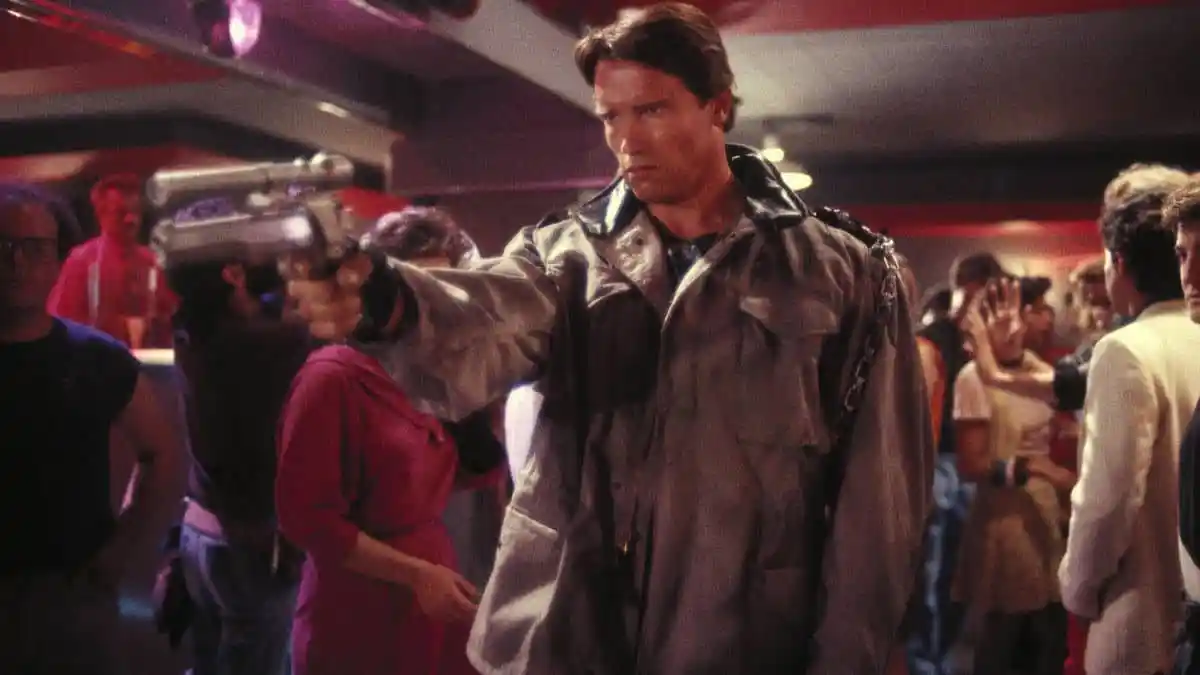The Terminator is often discussed in terms of its contributions to specifically science fiction cinema. Prolific science fiction author Harlan Ellison earned an acknowledgement in the closing credits by filing a lawsuit alleging that the film stole various ideas from his television script “Soldier” for The Outer Limits, even though writer and director James Cameron would later dismiss Ellison’s case as “a nuisance suit.” The Terminator contains elements associated with science fiction: time travel, cyborgs, post-apocalyptic warfare.
However, despite these trappings, The Terminator feels much more like a horror movie than a conventional science fiction adventure. Indeed, even beyond the shoestring budget and technical limitations imposed on the production, The Terminator stands apart in Cameron’s filmography. It is arguably closer in tone to the original Alien than Cameron’s sequel Aliens, using recognizable science fiction storytelling devices to frame an archetypal horror narrative.
It makes sense that The Terminator should feel like a horror. Cameron conceived of the film while in Rome working on his directorial debut, Piranha II: The Spawning. Cameron concedes the nightmare may have been prompted by a fever, but added, “I think also the idea that because I was in a foreign city by myself and I felt very dissociated from humanity in general, it was very easy to project myself into these two characters from the future who were out of sync, out of time, out of place.”
This nightmarish quality bleeds through into the film. The Terminator presents Los Angeles as a haunted landscape, particularly at night. While Kyle Reese (Michael Biehn) arrives in the city, it is a labyrinth of dark alleyways lit by the neon strobe of police lights. The Terminator repeatedly suggests that Reese has swapped one nightmare for another, paralleling the homeless inhabitants of 1984 Los Angeles scavenging for food with the survivors foraging in the ruins of the apocalyptic future.

The presentation of Los Angeles in The Terminator is in step with the broader portrayals of the American city as a sprawling wasteland in contemporary films like RoboCop or even After Hours. The Terminator has been described as “basically Walter Hill’s best film,” recalling the urban nightmares of films like The Warriors or Streets of Fire. In particular, the use of washed out blues and greens in the nighttime scenes evokes a feeling of chronic insomnia, a blurring of dream and reality.
As played by Arnold Schwarzenegger, the Terminator itself might have a pseudo-rational explanation, but it is also just a literal distillation of the classic slasher villain. Like Michael Myers or Jason Voorhees, characters driving the popular horror franchises of the decade, the Terminator is a relentless and unstoppable killing machine. Cameron emphasizes this with repeated shots of the machine getting knocked down, seemingly defeated, only to twitch back to life to continue the pace.
Cameron is not shy about acknowledging this influence. “My contemporaries were all doing slasher-horror movies,” Cameron has explained. “John Carpenter was the guy I idolized the most. He made Halloween for $30,000 or something. That was everyone’s break-in dream, to do a stylish horror movie. It was a very slasher film type image. And it really was the launching pad for the story.” Carpenter’s influence looms large over the film, especially Halloween and Assault on Precinct 13.
This is most obvious in an early sequence in which the Terminator murders Ginger (Bess Motta) and her boyfriend Matt (Rick Rossovich). Ginger and Matt have just had sex, which makes them prime targets in a horror movie. Ginger makes a sandwich, leaving Matt lying in bed in the dark room. The Terminator quietly enters and brutally murders Matt as Ginger listens to her headphones in another room. Ginger is oblivious to her boyfriend’s death until his head is smashed through a wall.

However, what is particularly interesting about The Terminator is how it uses these horror movie tropes in interesting ways. Even on his second film, Cameron was cognizant of what these devices could mean. Although Schwarzenegger has joked that Cameron declined to O.J. Simpson as the Terminator because Simpson was not “believable for a killing machine,” Cameron has also candidly admitted, “I wasn’t interested in an African-American man chasing around a white girl with a knife.”
It is worth considering Sarah Connor (Linda Hamilton), the target of the time-traveling assassination cyborg. Sarah is introduced in a manner similar to the young women who tended to headline these sorts of horror movies, like Laurie Strode (Jamie Lee Curtis) in Halloween or Nancy Thompson (Heather Langenkamp) in A Nightmare on Elm Street. While the Terminator and Reese navigate a gritty urban nightmare, Sarah is introduced riding a pink scooter against a clear blue sky.
In some ways, Sarah could be seen as an embodiment of the classic horror movie “final girl.” She is young, with 27-year-old Hamilton playing an 18- (or 19-) year-old character. She is wholesome, working a low-paying job at a diner to make ends meet. She is also presented as somewhat more chaste than Ginger. While Ginger spends the night at home with Matt, Sarah is getting stood up on a date. (The voice on the answering machine is Cameron himself, Hamilton’s future husband.)

Cameron doesn’t play all the classic horror movie tropes straight. Instead, he actively and pointedly subverts some of the core elements of the slasher movie template. The sexual politics of horror movies are undoubtedly complicated, with many critics reading the slasher genre as inherently misogynistic while others argue that it has embraced a progressive feminism over time. Still, however one reads the genre, there is a strong puritanical undertone to its attitudes towards sex.
In horror movies, female characters are often punished for having sex. In the self-aware horror movie Scream, film buff Randy (Jamie Kennedy) explains, “You can never have sex.” When the audience boos, he doubles down, “Sex equals death, okay?” In the equally self-aware Cabin in the Woods, the moral logic of horror movies is framed in terms of transgression. Gary (Richard Jenkins) clarifies, “If they don’t transgress, they can’t be punished.”
In many horror films, for many female characters, sex itself is treated as a transgression worthy of punishment. The “final girl” in these films is often defined by her abstinence, in contrast to the characters around her. “Good girls don’t die, but loose ones do,” summarizes Adam Rockoff. “To simplify it further, the girls who refrain from having sex survive(;) the ones who indulge in their passions die.” This allows the audience of such films to have their cake and eat it: to be titillated by the sexual content of these slasher films, but to be reassured that morality is ultimately upheld.

There are legitimate criticisms to be made of the sexual politics of Cameron’s films. His films lean heavily on the importance of his female characters as mothers. In Dark Fate, Sarah herself mounts a fair retroactive criticism of the original Terminator. When Dani (Natalia Reyes) freaks out about being targeted by killer robots from the future, Sarah sarcastically sighs, “You’re not the threat. It’s your womb.” While the original Alien offered a genuinely radical portrayal of its protagonist Ripley (Sigourney Weaver), Cameron constructs a surrogate nuclear family for her in Aliens.
However, in the context of The Terminator and the larger slasher genre, this emphasis on motherhood becomes slyly subversive. The Terminator is built around Sarah’s sexual agency. In the conventional slasher movie, the heroine dies if she has sex. In The Terminator, humanity itself dies if Sarah doesn’t have sex. When Reese and Sarah have sex in the third act of The Terminator, shortly before the Terminator’s final attack, it is Reese who becomes expendable and is brutally murdered.
The result is to make The Terminator a subtly subversive slasher movie, albeit a movie that is rarely discussed in those terms. It’s a movie that exemplifies much of the appeal of low-budget horror filmmaking, but it also offers a sophisticated twist on the classic template. Perhaps The Terminator saw the future in more ways than it initially appeared.






Published: Aug 1, 2020 04:27 pm